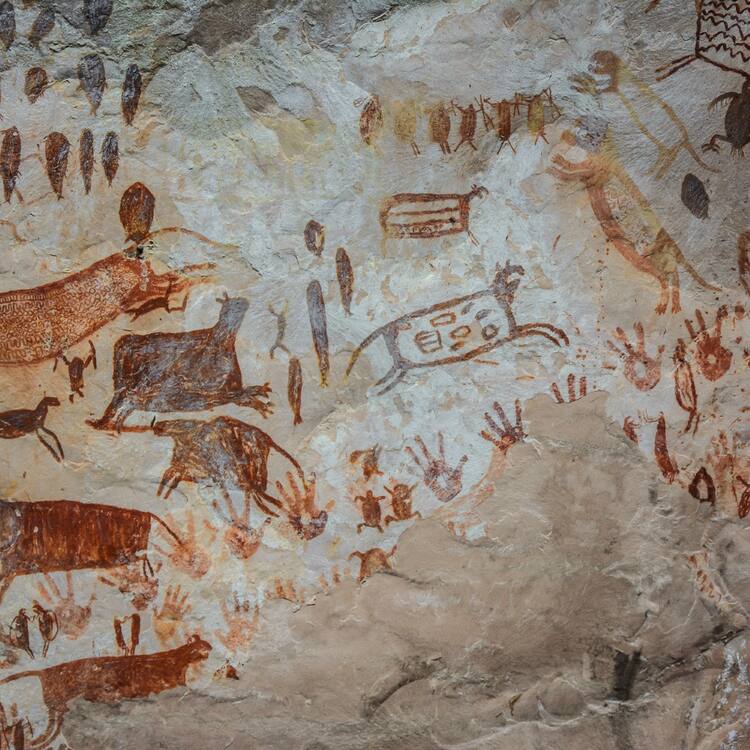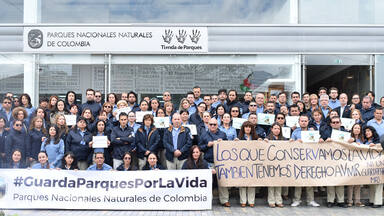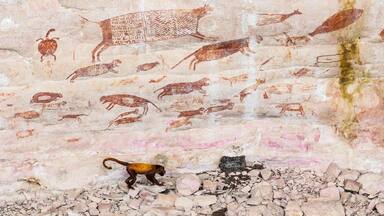Chiribiquete National Park – “The Maloca of the Jaguar”
Chiribiquete National Park – “The Maloca of the Jaguar”
Chiribiquete National Park, the largest protected area in Colombia, is the confluence point of four biogeographical provinces: Amazon, Andes, Orinoco and Guyana. As such, the National Park guarantees the connectivity and preservation of the biodiversity of these provinces, constituting itself as an interaction scenario in which flora and fauna diversity and endemism have flourished. One of the defining features of Chiribiquete is the presence of tepees (table-top mountains), sheer-sided sandstone plateaux that outstand in the forest and result in dramatic scenery that is reinforced by its remoteness, inaccessibility and exceptional conservation. Over 75,000 figures have been made by indigenous people on the walls of the 60 rock shelters from 20,000 BCE, and are still made nowadays by the uncontacted peoples protected by the National Park. These paintings depict hunting scenes, battles, dances and ceremonies, as well as fauna and flora species, with a particular the worship of the jaguar, a symbol of power and fertility. The indigenous communities, which are not directly present on the site, consider Chiribiquete as a sacred place that cannot be visited and that should be preserved unaltered.
Description is available under license CC-BY-SA IGO 3.0
Parc national de Chiribiquete - « La Maloca du jaguar »
Le parc national de Chiribiquete, la plus grande aire protégée de la Colombie, est le point de confluence de quatre provinces biogéographiques : Amazon, Andes, Orinoco et Guyanes. En tant que tel, le parc national garantit la connectivité et la préservation de la biodiversité de ces provinces, en se constituant comme un scénario d'interaction dans lequel la diversité de la flore et de la faune et de l'endémisme ont prospéré. Une des caractéristiques déterminantes de Chiribiquete est la présence de tepuys (montagnes tabulaires), des plateaux de grès aux parois abruptes qui dominent la forêt et offrent un paysage spectaculaire rehaussé par son isolement, son inaccessibilité et sa conservation exceptionnelle. Plus de 75 000 peintures ont été réalisés par les peuples autochtones sur les parois des 60 abris sous roche datant de 20 000 ans avant notre ère, et le sont encore de nos jours par les peuples isolés protégés par le parc national. Ces peintures représentent des scènes de chasse, des batailles, des danses et des cérémonies, ainsi que des espèces de faune et de flore, avec notamment le culte du jaguar, symbole du pouvoir et de la fertilité. Les communautés autochtones, qui ne sont pas directement présentes sur le bien, considèrent Chiribiquete comme un lieu sacré qui ne peut pas être visité et qui devrait être préservé sans modification.
Description is available under license CC-BY-SA IGO 3.0
حديقة شيريبيكيت الوطنية (لا مالوكا دو كاغوار)
تعدّ حديقة شيريبيكيت الوطنية، الواقعة في الجزء الشمالي الغربي من منطقة الأمازون الكولومبية، أكبر منطقة محمية في البلد. وتتميّز بمجموعة من السمات ومنها مثلاً وجود قمة "تيبوأوس"، وهي كلمة بلغة الأمريكيين الهنود وتعني "جبل"، بالإضافة إلى هضاب الحجار الرملية في المنحدرات المنتشرة في جميع أنحاء الغابة. وهناك أكثر من 75 ألف لوحة تشكلت في الفترة الممتدة منذ 20 ألف عام قبل الميلاد وحتى يومنا هذا، على جدران 60 ملاذاً من الملاذات الصخرية المحيطة بقاع هذه الجبال. وتجسّد هذه الرسومات المرتبطة بإحدى عقائد الكاغوار، والتي ترمز للقوة والخصوبة، مشاهد صيد ومعارك ورقص واحتفالات. وتعتبر هذه المنطقة مقدسة بالنسبة للمجتمعات المحلية غير الممثلة على القائمة تمثيلاً مباشراً. وستستمر أعمال الدورة الثانية والأربعين للجنة التراث العالمي حتى تاريخ 4 تموز/يوليو.
source: UNESCO/CPE
Description is available under license CC-BY-SA IGO 3.0
奇里比克特国家公园,“美洲豹的居所”
奇里科克国家公园是哥伦比亚最大的保护区,位于该国西北部的亚马逊地区。公园的特色之一是俯瞰森林、四周陡峭的砂岩高原tepuis(印第安语,意为桌面山脉)。在Tepuis基座周围的60个岩棚石壁上有超过7.5万幅岩画,时间跨度从2万年前到现在。这些绘画描绘的是狩猎、战斗、舞蹈和仪式场景,相信与美洲豹崇拜有关,美洲豹是力量和生育力的象征。土著人民视这里为圣地,遗产地没有土著社区的直观迹象。
source: UNESCO/CPE
Description is available under license CC-BY-SA IGO 3.0
Национальный парк Чирибикете - «Малока клана Ягуара»
Расположенный в северо-западной части колумбийской Амазонии, Национальный парк Чирибикете является крупнейшим заповедным районом страны. Одной из особенностей этого парка являются тепуи (слово индейского происхождения, означающее «гора») – песчаные плато с крутыми склонами, возвышающиеся над лесом. Более 75 тыс. наскальных рисунков, относящихся к периоду около 20 тыс. летдо нашей эры, вплоть до настоящего времени, покрывают стены 60 скальных пещер, расположенных у подножия тепуй. Связанные с предполагаемым культом ягуара, символом мощи и плодородия, эти рисунки изображают сцены охоты, битв, танцев и церемоний. Коренные общины, не проживающие непосредственно на территории объекта, считают этот регион священным.
source: UNESCO/CPE
Description is available under license CC-BY-SA IGO 3.0
Parque Nacional de Chiribiquete – “La maloca del jaguar”
Situado al noroeste de la Amazonia colombiana, el Parque Nacional de Chiribiquete es el territorio natural protegido más extenso de todo el país. Una característica del sitio es la presencia de tepuyes, grandes formaciones rocosas elevadas y aisladas, de pendiente vertical y cimas planas, que dominan la jungla. En las paredes de unas 60 grutas situadas al pie de estas elevaciones hay más de 75.000 pinturas cuya ejecución se remonta a unos 20.000 años antes de nuestra era. Presuntamente relacionadas con un culto al jaguar, símbolo de potencia y fertilidad, esas expresiones pictóricas representan escenas cinegéticas, guerreras, danzantes y ceremoniales. Las comunidades indígenas que no se hallan directamente presentes en este sitio lo consideran territorio sagrado.
source: UNESCO/CPE
Description is available under license CC-BY-SA IGO 3.0
Outstanding Universal Value
Brief synthesis
Chiribiquete National Park – “The Maloca of the Jaguar” is in the Amazon rainforest in south central Colombia. Following its extension in 2013, the park is now the largest national park in Colombia at 2,782,354 hectares and is very large by global standards for protected areas. It is located at the western-most edge of the Guiana Shield and contains one of only three uplifted areas of the Shield called the Chiribiquete Plateau. One of the most impressive defining features of Chiribiquete is the presence of many tepuis which are table-top mountains, found only in the Guiana Shield, notable for their high levels of endemism. The tepuis found in Chiribiquete, whilst smaller when compared to others in the Guiana Shield, result nonetheless in dramatic scenery that is reinforced by their remoteness and inaccessibility. A particularly significant value of the property is its high degree of naturalness which makes it one of the most important wilderness areas in the world.
Some 75,000 rock pictographs have been listed on the walls of 60 rock shelters at the foot of tepuis. The portrayals are interpreted as scenes of hunting, battles, dances and ceremonies, all of which are linked to a purported cult of the jaguar, seen as a symbol of power and fertility. Such practices are thought to reflect a coherent system of thousand-year-old sacred beliefs, organizing and explaining the relations between the cosmos, nature and man. The archaeological sites are believed to be accessed even today by indigenous uncontacted groups.
Chiribiquete is home to many iconic species including Jaguar, Puma, Lowland Tapir, Giant Otter, Howler Monkey, Brown Woolly Monkey. A high level of endemism occurs in the property and the number of endemic species is likely to rise substantially once new research programmes are implemented.
The global significance of the property to biodiversity conservation is reflected by the fact that it is considered a Centre of Plant Diversity, an Important Bird Area, an Endemic Bird Area, a Key Biodiversity Area and it is the only site protecting one of the terrestrial ecoregions of flooded forests called “Purus Varze”, considered Critical/Endangered by WWF International. The biodiversity values of the property are inextricably linked to its significant cultural and archaeological values that are strongly associated to the beliefs and spiritual values of the indigenous peoples living in the property.
Criterion (iii): The rock art sites of Chiribiquete hold an exceptional testimony, by the large number of painted rock shelters around the foot of rare tepui rock formations, by the diversity of motifs, which are often realistic, and by the chronological depth and persistence up to the present-day of the purported frequentation of the sites by isolated communities. The first inhabitants of Amazonia practised their art on the rock walls of Chiribiquete, and these paintings constitute an exceptional testimony of their vision of the world. Chiribiquete is even today considered to be of mythical importance by several groups and is designated the “Great Home of the Animals”.
Criterion (ix): The property, due to its unique location in the middle of two Pleistocene refuges (Napo and Imeri) and its function as a corridor between three biogeographic provinces (Orinoquia, Guyana, and Amazonia), hosts unique species with distinctive adaptations that are thought to have resulted from its geographical isolation. It is located in the Chiribiquete-Araracuara-Cahuinari Region Centre for Plant Diversity and has been identified as a gap. The property overlaps entirely with Serrania de Chiribiquete, which is listed amongst the most irreplaceable protected areas in the world for the conservation of mammal, bird and amphibian species. The property is located in a unique biogeographical context where evolutionary processes have shaped the high floral and faunal diversity. It presents a mosaic of mainly Guyanese and Amazonian landscapes that provide a great variety of unique habitats that are critical for the survival of the property’s characteristic plants and animals.
Criterion (x): Despite the fact that limited scientific research has been undertaken in the property, data available shows that 2,939 species have been recorded. These include 1,801 species of vascular plants, 82 species of mammals (including 58 bat species and a bat species new to science) as well as a number of globally threatened species such as the Giant Otter, Giant Anteater, Lowland Tapir, Common Woolly Monkey and Jaguar, 60 species of reptiles, 57 species of amphibians, 492 species and subspecies of birds (including a new endemic species, the Chiribiquete Emerald Hummingbird), 238 fish species and 209 species of butterflies (including to date at least 6 potentially new species). The number of species, including of endemic species (21 endemics reported) would most certainly rise as more scientific expeditions are undertaken in the future.
Integrity
Chiribiquete National Park contains all the elements necessary for the expression of its Outstanding Universal Value, and is of an appropriate size for the satisfactory preservation of the conditions of integrity. The isolated location of these sites, which are hard to access, and the cultural restrictions on access and the making of paintings ensure the comprehensive representation of the characteristics and processes that express the importance of the property.
The property overlaps with Serrania de Chiribiquete Natural National Park, which includes 13 geomorphologically distinct types of tepuis as well as arches, labyrinths, caverns and structural cracks more than 10 meters wide, all of which contribute to the biodiversity richness of the property. All of these landform features are intact as well as the surrounding forests and river systems.
The property is exceptionally large and adequately provides refuge for the many species and habits present. The boundaries of the property have been drawn to include the vast majority of the tepuis and other significant landforms. The national park was expanded in 2013 to include areas to the north that provide additional connectivity with the Andes and to the east providing additional connectivity with the Orinoco.
The property is remarkably well-preserved and is in excellent condition. No infrastructure has been built and none is planned. There are two main threats: those related to ensuring respect of rights for the uncontacted tribes living in voluntary isolation, and those related to the loss of habitats, biodiversity and connectivity. Tourism and scientific expeditions are a potential threat to the rights to self-determination, territory and culture of the uncontacted tribes. Threats potentially affecting the natural values of the property are habitat loss due to agricultural encroachment; however, these threats are mainly affecting the buffer zone and are subject to active management programmes. A temporary suspension of mining licenses in the buffer zone has been issued and should be maintained in the long-term to avoid this indirect threat. Small areas within the property have been occasionally used for illegal farming but this has been fully eradicated. At present, there is no tourism allowed inside the property and it is important to strictly control any tourism access.
Authenticity
The rock art sites are authentic in terms of situation and setting, intangible culture, spirit and impression, materials, form and conception. The chronological attribution of the paintings, and the assertion of a continuous sequence of rock art will need to be confirmed, but this does not mean that the rock art itself lacks authenticity, but merely that there are questions about its interpretation.
Protection and management requirements
Chiribiquete National Park is legally protected by the Colombian government, as a national park that was listed in 1989. The property is administered by the System of National Natural Parks (SPNN). The authority responsible for the management of the archaeological sites is the Colombian Institute of Anthropology and History (ICANH). The buffer zone is made up entirely of reserves for indigenous groups and the Amazonia Forest Reserve. The zones surrounding the protected area are Type A Forest Reserve Zones inside which mining is prohibited. While there are no direct threats to the property itself, there are considerable threats to the buffer zone as agriculture and road building move closer to the buffer zone boundary.
The local communities whose territories lie in the buffer zone are still based on the traditional forms of organisation that have ensured the protection and conservation of the property over a long period of time. To guarantee the conservation of the archaeological sites, their monitoring is based on minimum intervention parameters and the safeguarding of the transmission of ancestral knowledge. Major legal measures have been taken to protect the isolated indigenous communities in the region. The management of the property includes respect for customary practices with regards to access to the property, as defined by the Amazon Area Directorate in the management scenarios for protected areas in national natural parks.
A management plan, drawn up by Colombia’s System of National Natural Parks, is in place for the period 2016-2020. It includes provisions on management activities required for the different land use zones as well as expected biodiversity conservation outputs derived from these actions. The zones in the park are enabled through Decree 622 of 1977 that establishes six distinct zones for all Natural National Parks. Two aspects are prioritised: the first is the overlapping of Chiribiquete National Park with territories that are not recognised reserves; the second is overlapping with uncontacted territories or territories in a situation of voluntary isolation. Given that there are no direct pressures inside the property, a significant proportion of the management is implemented in the buffer zone by the SPNN and by the ICANH.
Overall, the management of the property is well-organized with good capacity for planning and operations. Patrolling and protection activities are actively supported by the army that has played a key role for many years in assisting with the location and eradication of illegal coca plantations inside the property and in the buffer zone. Efforts should be directed at maintaining the good cooperation established with the army or anticipating the need to replicate this level of protection through other means should the military presence change. Funding to support the management of the property results from a combination of financial and human resources provided by the State Party and also supported by international projects, thus the current level of financial resources is considered sufficient to implement key provisions of the management plan related to nature conservation, and should be maintained. However, available financial and human resources dedicated to management activities and for the development of infrastructure and the acquisition of equipment for patrolling and other management actions should be increased following inscription. New challenges, for example linked to tourism development, may arise from the inscription of the property which will require continued attention and further investment.



